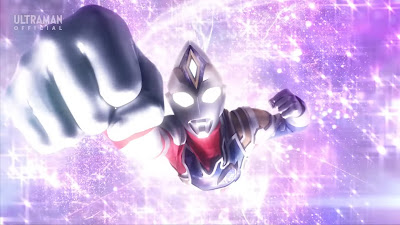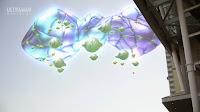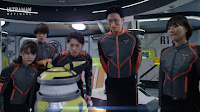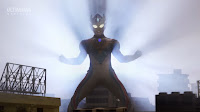Seven years after Ultraman Trigger and GUTS-Select defeated the Giants of Darkness and saved the world, humanity has entered a "Neo Frontier Era". There hasn't been a monster attack in years, to the point where GUTS-Select can rely on an entirely automated arsenal. However this peaceful time comes to a swift end with the arrival of the Sphere - a mysterious alien race that quickly decimates Earth's defences.
As GUTS-Select members are redeployed for protection and defence, rice cracker store worker Kanata Asumi also gets caught up in the attack. After helping save a woman trapped in rubble, Kanata is seemingly swallowed up by a Sphere craft. But in a mysterious void, a voice calls out to him - presenting him with the Ultra D Flasher and Ultra Dimension cards. Becoming Ultraman Decker, Kanata is able to push back the Sphere invasion but unable to stop them from covering the planet in an impenetrable forcefield. Cut off from the rest of the universe, GUTS-Select reforms its Monster Response Department with Kanata as its newest recruit. One year later, they continue to defend the planet from monster attacks as well as the constant threat of the Sphere. As time passes and the origins of both Decker and the Sphere emerge, they learn that their battle is one where the future truly hangs in balance.
While the popularity of Ultraman Dyna is enough to understand why Tsuburaya would follow up Trigger with a series in a similar vein, it's interesting that Ultraman Decker didn't start out as a "New Generation Dyna" or even a Trigger sequel. In fact recent behind the scenes interviews have suggested this instead came from a need to reuse assets from Ultraman Trigger in order to retain the more extensive use of a defence team. But whatever the reason, Ultraman Decker's parallels to its 1997 predecessor couldn't feel more timely. The Sphere invasion and encapsulation of the planet Earth acts as the perfect parallel to real-world events, with humanity suffering the same sense of isolation from the rest of the universe as many did under lockdown during the COVID-19 pandemic. It's when Ultraman Decker focuses on this element of its story that it was arguably at its strongest, not only seeing how this global lockdown affected humanity but also the aliens trapped as a result of the Sphere attacks.
Ultraman's newest protagonist is Kanata Asumi, who continues to fit the mould of cheerful yet somewhat goofy heroes who'll never shy away from doing what's right. Even as a civilian we see immediately see him risk his life to save others, which in turn sets him on the path to becoming Ultraman Decker. One particularly strong element to his character that takes centre stage in the early episodes is Kanata finding his reason to fight - having been thrown into this double life as both Ultraman Decker and a GUTS-Select member compared to his colleagues. Later revelations in the story lead to Kanata almost losing to focus, having to balance knowledge he's learned secretly as Ultraman Decker with his duty and the relationship he has with his teammates. On his own Kanata's nature might not sound like it stands out all that much from his predecessors, but it's the relationships he develops with both his friends and enemies that truly define him as a hero.
Arguably one of the biggest issues in Ultraman Trigger was its inability to sufficiently develop its (relatively large) cast in the limited time in had, and this is one mistake Ultraman Decker tried not to repeat. Right from the get-go Decker deals with a much tighter cast where not everyone's role in the team is clear, but everyone gets at least one proper focus episode to show their worth as well. Among the new GUTS-Select team are the hot-blooded Ichika Kirino, the cool-headed Soma Ryumon, monster expert and Nursedessei operator Sawa Kaizaki and captain Taiji Murahoshi. While Taiji and Sawa largely head up operations from the Nursedessei, Ichika and Soma work as field operatives alongside Kanata - developing a great dynamic over the course of the series. Laying out each of their own resolves to fight back against the Sphere, each one brings a different strength to the team - a quality that's perfectly summed up in the show's final episode by their captain. Although this version of GUTS-Select lacks an alien on the team, it does instead have HANE2 (nicknamed 'Hanejiro' in tribute to the Dyna character of the same name). In addition to providing aerial support as the pilot of the GUTS Hawk, as the first (and for the most part only) character to know of Kanata's identity as Decker the two build up a brilliant rapport. But while Decker's ability to develop these characters as individuals is key to its success, what's perhaps more integral is how well it's able to establish GUTS-Select as a team. Decker will usually be the one to save the day, but Ultraman as a franchise has reached a point where it can comfortably push the defence teams as key part of the action again and it's all the stronger for it.
The Sphere may be the overarching villain of Ultraman Decker, but for the most part their presence is one of a looming threat. As Decker's story ramps up in its second half, it turns toward a singular figure as the main source of conflict. An alien from the far future whose life was destroyed by the Sphere attacks, Agams is in part a tragic figure. By the time he begins to enact his plan, he has become so consumed by revenge that he is unable to see reason - so much so that he goes as far as to ally himself with the architects of his tragedy because he genuinely believes humanity are the ones to blame. This instability, and in turn unpredictability, makes Agams a captivating villain even when repetition begins to bog the series down. Even with the continued presence of episodic storylines, Decker as a whole largely becomes a clash of ideals between Kanata and Agams - as well as a physical one in the form of Agams' Terraphaser robot.
Though Decker doesn't have "New Generation Dyna" in its title the same way Ultraman Trigger did, for all intents and purposes it aims to pay tribute to Ultraman Dyna in the same way Trigger did for Tiga. There are plenty of similar plot lines and story parallels to be picked up on by Dyna fans, but presented in a way intended to enhance Decker rather than make Dyna required viewing. It even goes as far as to expand Dyna lore where it can - putting far greater emphasis on the Sphere for example. But for better or worse, some of the more overt links remain somewhat vague - and for those who perhaps aren't familiar with Ultraman Dyna, frustratingly so. Whereas Trigger took time to carefully explain its callbacks to Tiga even when they weren't all that satisfying, Decker takes more of a "refuses to elaborate" approach. For example, while Tiga's physical appearance in Trigger was somewhat convoluted Dyna literally just turns up in Decker, fights and then leaves again. Similarly the future Agams' hails from sees Dyna involved in the conflict, but remains vague on how. With the uncertainty of the future being something of a mantra for Decker it could be argued that there's actually a certain charm to retaining an element of mystery - with Dyna's dimension-hopping nature straightforward enough to be understood without significant exposition.
But in addition to paying reverence to Ultraman Dyna, Ultraman Decker had a much more important challenge on its hands - acting as a competent sequel to Ultraman Trigger without losing the ability to stand alone. While it's fair to say that Ultraman Trigger has proven to be one of the more divisive entries in the New Generation lineup, the good Decker did with its cast and setting may be enough to consider it worthy of some reevaluation. But for all the problems Trigger had, Kengo Manaka was not one of them and here he shines as brightly as ever. Even in the face of the Sphere invasion his unrelenting positivity hasn't wavered, and in turn acts as a mentor of sorts to Kanata - guiding him through his journey as Ultraman in a number of appearances. While this initial appearance may act as a direct epilogue to Trigger's own storyline (proving a strong conclusion to Keno's dynamic with Carmeara as well as, perhaps rather awkwardly, suggesting a second chance for all three Dark Giants), later ones are far more ingrained in Decker's storyline - with Trigger supplementing the story rather than dominating it. As nice it would have been to see all of the original GUTS-Select team, largely keeping it to Kengo/Trigger kept the cast from getting too bloated. Even with Trigger reuniting with Decker once more for the show's finale, the focus was kept squarely on Kanata and the rest of the GUTS-Select team because they were the characters the audience followed over the past 25 episodes. Put simply, Decker has an understanding of Ultraman Trigger where it was able to draw upon its strengths in a way that makes you forget about its flaws.
That all said, Ultraman Decker still hasn't completely been able to get away from the stranglehold that the Showa era seems to have on the New Generation Heroes. While Decker might not have anything quite as egregious as an Ultra Galaxy Fight tie-in that derails its storyline, there are still some puzzling decisions for a series that's supposed to be channelling the essence of Ultraman Dyna. In addition to the Sphere themselves a cursory look at the various kaiju that appeared in Ultraman Decker shows that there were three that originally debuted in Dyna (Mons-Ahgar, Zomborg and Geomos), in addition to the numerous favourites from across Ultraman's history - including the likes of Gomora, Bemular, Eleking, Twin-Tail, Gudon and Red King. In addition to this there was also some representation from Tiga, as well as more modern creations like Galactron. As was the case with Ultraman Trigger, there are some fantastic episodes that centre around these classic monsters, but they're the kind of stories that could fit into any New Generation series. Similarly early episodes reveal Decker has the same Capsule Monster gimmick (albeit in card form) originally popularised by Ultraseven, but is very quickly forgotten about as Decker's own story progresses. Links and parallels to Dyna may be present and presented in a way that they aren't to the detriment of new viewers, but even so it would be nice if the "New Generation Dyna" series played into these things more. But on the other hand, given the tight budget Tsuburaya are working on with these shows it isn't surprising things have turned out this way. Given the choice between remaking/renovating a classic kaiju suit or an Ultraman Dyna one, the classic kaiju is always going to win because it's the one Tsuburaya will be able to get the most mileage out of. As a result, we end up seeing all these iconic monsters reappearing because they're the ones the creators have at their disposal. It's perhaps less of a criticism of Decker and more of an indictment of "that's just the way things are", but with both Trigger and Decker having a more distinct identity than the other New Generation series it becomes a little more obvious.
If budget truly is a factor though, Ultraman certainly never shows it onscreen. Like its predecessors Ultraman Decker is a visual delight, with Tsuburaya virtually unrivalled when it comes to both the craft and heart of tokusatu as a medium. The set designs and miniatures remain as immaculate as ever, with the kind of detailing it's hard to believe so goes into something about to be destroyed. Decker's design is the ideal update of the original Dyna template - keeping all of its key aspects whilst also making it its own with that gorgeous cosmic pattern across the chest and forehead. With his initial Flash, Miracle and Strong Types Decker pays homage to Dyna's own various forms, eventually breaking free to something wholly unique with Dynamic Type. The new monsters on display are similarly impressive - from the aforementioned Terraphaser to the ferocious Sphere-themed creatures, including new interpretations of classics like Gomora and Red King.
Ultraman Decker is a good return to form for the Ultraman franchise, learning from the mistakes of Ultraman Trigger to provide a series whose characters are just as engaging as its story. In turn, its links back to Trigger are able to enhance that series - serving its protagonist in a way some might argue he was originally denied. That said Decker still suffers from some of the same pitfalls, often placing more of an emphasis on strong episodic stories rather than fully capitalising on its core premise. Its strengths as a "New Generation Dyna" are debatable, but nevertheless there's enough here for Decker to stand comfortably on its own feet. While it's a shame that Tsuburaya won't be finishing up the trilogy with a "New Generation Gaia" series, it'll be interesting to see how they celebrate ten years of New Generation Heroes with the suspected "Ultraman Blazar". And before then, there's still Ultraman Decker Finale: Journey to Beyond to look forward to as well.
















4 comments:
Given that Ginga was going to be a Gaia sequel, it would be cool if Blazer combined elements from Gaia and Ginga.
Another important note is that Masashi Taniguchi became the second Tokusatsu Actor to complete the Tokusatsu Trifecta or Triple Crown after Kane Kosugi. He previously played Nagare Tatsumi/GoBlue in Kyuukyuu Sentai GoGoFive (1999-2000), Jin Takayama/Kamen Rider Amazons Alpha in Kamen Rider Amazons (2 Seasons; 2016-2017), Bacht/Kamen Rider Falchion in Kamen Rider Saber (2020-2021) and now, Alien Agams/Asumi Decker/Terraphaser in Ultraman Decker (2022-2023). So, who's gonna be the next Tokusatsu Actor/Actress that will obtain the said title? You'll never know!
I really love your reviews : your blog's been an invaluable help for the last two years in my discovery of tokusatsu. Your pieces are well-written and nuanced, really great for choosing series according to my own tastes and preferences, and I hope you'll keep going for a long, long while. I'm getting ready to retro-watch Taiga now that Decker's done, and I'm looking forward to your review of KR Black Sun if you get around to watching it and writing about it. Anyway, thanks again and keep up the good work!
Thank you so much for the kind words! Yes I will 100% be doing Black Sun next. I had started it but then some real life things got in the way, but l'm hoping to be back on track and have that review up in the next week or two :)
Post a Comment